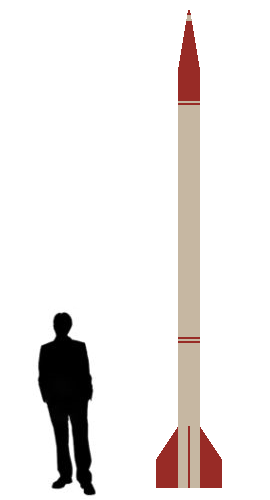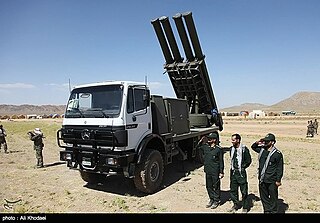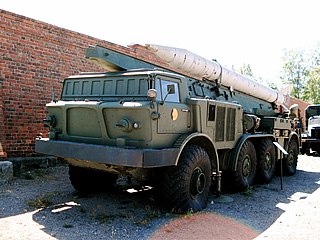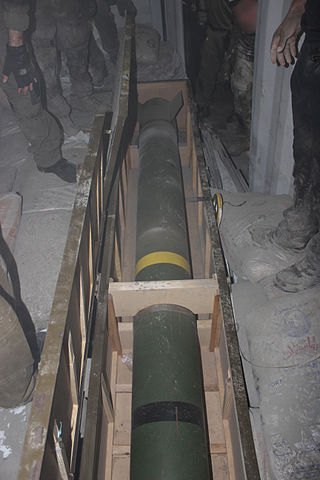
Rapier is a surface-to-air missile developed for the British Army to replace their towed Bofors 40/L70 anti-aircraft guns. The system is unusual as it uses a manual optical guidance system, sending guidance commands to the missile in flight over a radio link. This results in a high level of accuracy, therefore a large warhead is not required.

The M270 Multiple Launch Rocket System is an American armored self-propelled multiple launch rocket system.

AGM-123 Skipper II is a short-range laser-guided missile developed by the United States Navy. The Skipper was intended as an anti-ship weapon, capable of disabling the largest vessels with a 1,000-lb (450-kg) impact-fuzed warhead.

Avibrás Indústria Aeroespacial, based in Jacareí, São José dos Campos, Brazil, is a diversified Brazilian company which designs, develops and manufactures defense products and services. Its range of products encompasses artillery and aircraft defense systems, rockets and missiles such as air-to-ground and surface-to-surface weapon systems, including artillery rocket systems; 70 mm air-to-ground systems and fiber optic multi-purpose guided missiles. It makes armoured vehicles as well. It also manufactures civilian transportation through a division called Tectran, telecommunications equipment, electronic industrial equipment (Powertronics), automotive painting and explosives.

The Iranian Oghab sometimes spelled as Akab and Okab missile is an unguided 230 mm (9 in) artillery rocket with a range of 34–45 km (20–28 mi). It is spin-stabilized in flight but has a proven circular error probable in excess of 500 m (1,500 ft), making it a highly inaccurate weapon. It carries a 70 kg (150 lb) high explosive fragmentation warhead, though it may also be able to carry chemical warheads. According to US sources, a modified version has been developed that could be carried and fired from Iranian Air Force F-14 Tomcat and F-4 Phantom II aircraft. The launcher is an elevatable triple-rail launcher assembly fitted to a Mercedes-Benz LA 911B 4×4 truck chassis.

The Fajr-3 is an Iranian heavy 240 mm intermediate-range multiple-launch artillery rocket (MLRS). The Fajr-3 is a license-built copy, with slight modifications, of a North Korean MLRS called the M-1985. The Fajr-3 was introduced in the 1990s and has since been exported to Syria, Hamas and Hezbollah.

The Fajr-5 is an Iranian 333 mm long-range multiple launch rocket system (MLRS). The Fajr-5 was developed during the 1990s and has since been exported to various armed actors in the Middle East.
The Islamic Revolutionary Guard Corps Aerospace Force, officially known as the Islamic Revolutionary Guard Corps Air and Space Force, is the strategic missile, air, and space force of the Islamic Revolutionary Guard Corps (IRGC). It was renamed from the IRGC Air Force to the IRGC Aerospace Force in 2009.

The 9K52 Luna-M is a Soviet short-range artillery rocket system which fires unguided and spin-stabilized 9M21 rockets. It was originally developed in the 1960s to provide divisional artillery support using tactical nuclear weapons but gradually modified for conventional use. The 9K52 was succeeded by the OTR-21 Tochka.
Fajr, an Arabic word meaning "dawn", refers to the Muslim dawn prayer.

The Khaibar-1, also known as the Khyber-1, M-302, B-302 and the R160 is a Syrian-made 302 mm unguided artillery rocket. It is best known for being used by Hezbollah against targets in northern Israel during the 2006 Lebanon War, and has also been used in the Syrian Civil War. It is a derivative of the Chinese WS-1 rocket.

Hezbollah, a Lebanese Shia Islamist political party and militant group, has an exceptionally strong military wing, thought to be stronger than the Lebanese Army and equivalent to the armed strength of a medium-sized army. A hybrid force, the group maintains "robust conventional and unconventional military capabilities", and is generally considered to be the most powerful non-state actor in the world.

The Palestinian rocket arsenal used in the Arab–Israeli conflict includes a wide range of rockets and missiles, varying in design, size and payload capacity. Palestinian rockets include those locally made in Gaza and the West Bank as well as weapons smuggled from Iran and Syria. Rockets are used in attacks on Israel, mostly to target Israeli civilian centers in addition to Israeli military posts. Various Palestinian groups have used rockets against Israel including Fatah, Hamas, Islamic Jihad, as well as left-wing groups. Rockets are one of the main weapons produced by Palestinian militant and terrorist groups.

EXTRA is an artillery rocket system developed and manufactured by Israel Military Industries (IMI) and used by Israel Defense Forces, Azerbaijan and Vietnam and Kazakh Army since 2013. It has a maximum range of 150km with a 120kg unitary warhead and accuracy of 10m CEP.

The Šumadija is a Serbian self-propelled multiple rocket launcher in development since 2017. It is based on Kamaz truck chassis and it is modular in design. It can launch 4 400mm up to 285 km range or 12 rockets 262mm up to 75 km range.
Operation Karbala 3, also known as the Battle of Al-Ummiyah, was an operation during Iran–Iraq War, which was launched by Iran from 30 August to 2 September 1986 with the operation code of "Hasbonallah wa Ne'mal Wakil ".

The Fajr-4 is an Iranian air-to-surface guided rocket that was first unveiled on 9 May 2020 through a video released by the IRGC Aerospace Force. In the video, the missile is seen undergoing a drop test from a Sukhoi Su-22 fighter-bomber. Videos released of Supreme Leader, Ayatollah Seyyed Ali Khamenei, paying a visit to an IRGC Aerospace Force suggest that Iran had already armed its Sukhoi Su-22's with a new air-to-surface missile.
The Shahin-1 and Shahin-2 are Iranian road-mobile truck mounted short-range fin-stabilized unguided 333 mm Artillery rockets. It was designed to be a cost-effective unguided rocket to destroy enemy troop concentrations, installations and fortifications at medium ranges. The rocket has been replaced in production by more capable artillery rockets however it is still in active uses.













